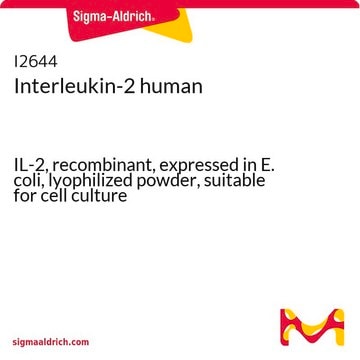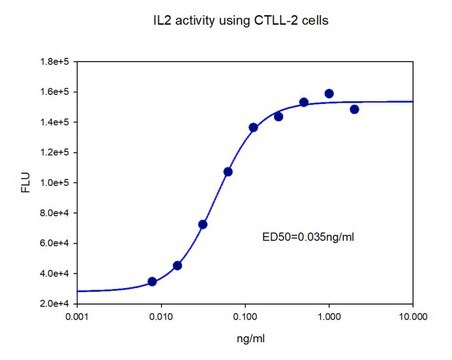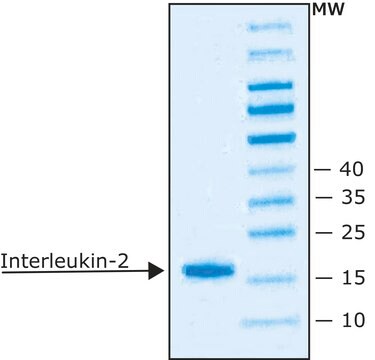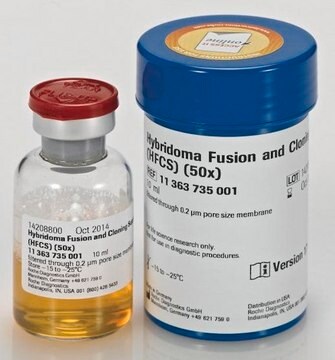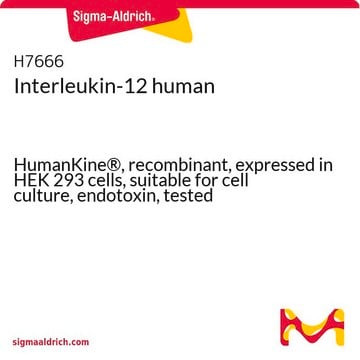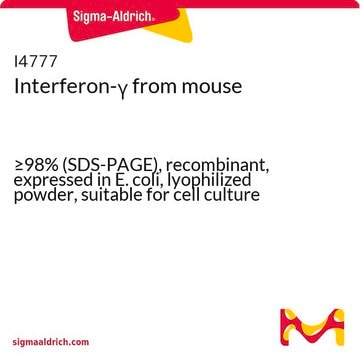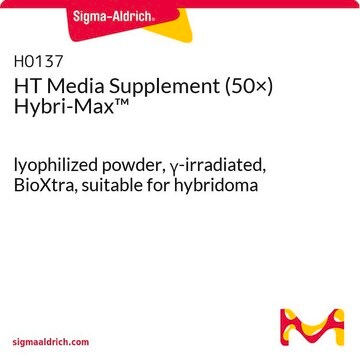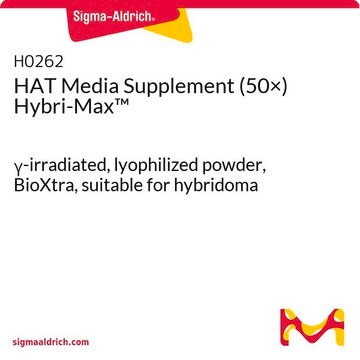11271164001
Roche
Interleukin-2, mouse (mIL-2)
recombinant (E. coli)
Synonyme(s) :
mIL-2, mouse interleukin-2
Se connecterpour consulter vos tarifs contractuels et ceux de votre entreprise/organisme
About This Item
Code UNSPSC :
12352207
Produits recommandés
Source biologique
mouse
Niveau de qualité
Produit recombinant
expressed in E. coli
Essai
>95% (SDS-PAGE)
Forme
solution
Puissance
<0.5 ng/mL EC50
Poids mol.
17,200 Da
Conditionnement
pkg of 10,000 U (5 μg, 1 ml)
Fabricant/nom de marque
Roche
Conditions de stockage
avoid repeated freeze/thaw cycles
Technique(s)
inhibition assay: suitable
Impuretés
<0.1 EU/μgtested (LAL test)
Numéro d'accès UniProt
Température de stockage
−20°C
Informations sur le gène
mouse ... Il2(16183)
Description générale
Contents: 10,000 U/ml solution in PBS and 1 mg/ml BSA, filtered through a 0.2 μm pore size membrane
Interleukin-2 (IL-2, also known as T-cell growth factor, TCGF) is a lymphokine produced by lectin- or antigen-activated T-cells. It plays an important immunoregulatory role. This factor was first identified by its ability to promote the long-term in vitro proliferation of activated T-cells. It also promotes the generation and proliferation of cytotoxic T-cells, natural killer (NK) cells, and lymphokine-activated killer (LAK) cells. IL-2 also induces other lymphokines such as interferon-γ and B-cell growth factor (BCGF-1).
Recombinant Interleukin-2, mouse (mIL-2), is produced in E. coli and purified by standard chromatographic methods.
Spécificité
Mouse IL-2 is effective on mouse cells, but not on human cells.
Application
Recombinant murine IL-2 is produced in E. coli and exhibits the following:
- Supports the growth of murine CTLL cells (murine T cell line), but not that of human T-cells.
- Strongly inhibits the binding of recombinant human IL-2 to murine responder cells.
- Weakly inhibits the binding to human responder cells.
- Shares identical biological and immunological activities with human IL-2.
- Is a convenient tool for extensive studies of the pharmacological and physiological activities of IL-2 in murine models.
- used for the stimulation of murine T-cells
Qualité
Endotoxin level: <0.1 EU/μg (LAL-test), <10 EU/ml (LAL-test)
Séquence
Chain Length 149 AA
One polypeptide chain (149 amino acids), identical to natural mouse IL-2, but not glycosylated. Glycosylation is not essential for biological activity.
Définition de l'unité
EC50 definition: The amount of mIL-2 that is required to support half-maximal stimulation of cell proliferation (XTT cleavage) with CTLL-2 cells (1 unit equals ≤0.5 ng).
Notes préparatoires
Working solution: Dilute the concentrated IL-2 solution (10,000 U/ml) with PBS or culture medium containing 1 mg/ml BSA [or HSA (human serum alburnin)], or 1 to 10% serum (v/v).
Storage conditions (working solution): -15 to -25 °C
Note: Avoid repeated freezing and thawing.
Storage conditions (working solution): -15 to -25 °C
Note: Avoid repeated freezing and thawing.
Autres remarques
Specific activity/EC 50: >2 x 106 U/mg, <0.5 ng/ml (hIL-2, NIBSC, 1st international standard, 86/504), at least the same specific activity (EC50) compared to the indicated standard is guaranteed.
Note: The biological activity of this product may vary in different in vitro applications. Determine the optimal concentration range for specific applications.
EC 50 definition/Unit definition: The amount of mIL-2 that is required to support half-maximal stimulation of cell proliferation (XTT cleavage) with CTLL-2 cells (1 unit equals =0.5 ng).
Note: The biological activity of this product may vary in different in vitro applications. Determine the optimal concentration range for specific applications.
EC 50 definition/Unit definition: The amount of mIL-2 that is required to support half-maximal stimulation of cell proliferation (XTT cleavage) with CTLL-2 cells (1 unit equals =0.5 ng).
For life science research only. Not for use in diagnostic procedures.
Code de la classe de stockage
12 - Non Combustible Liquids
Classe de danger pour l'eau (WGK)
nwg
Point d'éclair (°F)
No data available
Point d'éclair (°C)
No data available
Faites votre choix parmi les versions les plus récentes :
Déjà en possession de ce produit ?
Retrouvez la documentation relative aux produits que vous avez récemment achetés dans la Bibliothèque de documents.
Les clients ont également consulté
James Lee et al.
Methods in molecular biology (Clifton, N.J.), 506, 83-96 (2008-12-27)
In comparison to human T cells, efficient retroviral gene transfer and subsequent expansion of murine primary T cells is more difficult to achieve. Herein, we describe an optimized gene transfer protocol utilizing an ecotropic viral vector to transduce primary murine
Massimo Martinelli et al.
iScience, 26(1), 105860-105860 (2023-01-13)
The RNA-binding protein Pcbp2 is widely expressed in the innate and adaptive immune systems and is essential for mouse development. To determine whether Pcbp2 is required for CD4+ T cell development and function, we derived mice with conditional Pcbp2 deletion in
Anastasiia Kalinina et al.
STAR protocols, 2(1), 100368-100368 (2021-03-23)
Adoptive transfer therapy has great potential to treat diseases such as cancer as well as autoimmune and infectious diseases. Identification of chain-centric T cell receptors (TCRs) with the dominant-active antigen-specific α-chains (TCRα) can significantly improve the efficacy of adoptive cell therapy
Ping-Wei Zhao et al.
Mediators of inflammation, 2015, 762709-762709 (2015-04-22)
This study aimed to assess the differential expression of specific B cell subtypes in patients with chronic viral hepatitis. The frequencies of differential expression of specific B cell subtypes in patients with chronic viral hepatitis and healthy controls were assessed
Tae Joon Won et al.
Cellular signalling, 27(6), 1246-1252 (2015-03-13)
Small ubiquitin-like modifier (SUMO) 2 is a small protein that controls the activity and stability of other proteins by SUMOylation. In this study, T cell-specific SUMO2 overexpressing transgenic mice were generated to study the effect of SUMO2 on T lymphocytes.
Notre équipe de scientifiques dispose d'une expérience dans tous les secteurs de la recherche, notamment en sciences de la vie, science des matériaux, synthèse chimique, chromatographie, analyse et dans de nombreux autres domaines..
Contacter notre Service technique
